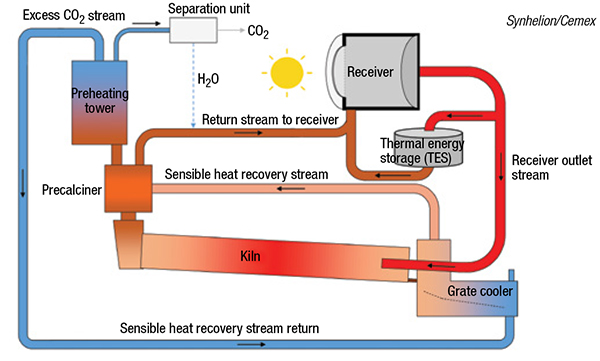Last month, Cemex, S.A.B. de C.V. (Cemex; Monterrey, Mexico; www.cemex.com) and Synhelion SA (Lugano, Switzerland; www.synhelion.com) successfully connected the clinker production process with the Synhelion solar receiver to produce solar clinker. The milestone is a first step towards fully solar-driven cement plants.

Clinker — a solid material used for making Portland cement — is produced by fusing together limestone, clay and other materials in a rotary kiln at temperatures nearing 1,500°C. Because fossil fuels are typically used to heat the kiln, they are responsible for approximately 40% of direct CO2 emissions of the process. Replacing fossil fuels entirely with solar-thermal energy is a gamechanger in the industry’s efforts to achieve carbon neutrality by 2050.
The Synhelion and Cemex R&D teams set up a pilot batch-production unit to produce clinker from concentrated solar radiation by connecting the clinker production process with the Synhelion solar receiver. The pilot was installed at the Very High Concentration Solar Tower of IMDEA Energy, located near Madrid, Spain. Synhelion’s solar receiver consists of a cavity filled with a greenhouse gas (GHG; typically water vapor or mixtures of H2O and CO2) flowing from the aperture towards the back of the cavity. Solar radiation coming from the 1,000-m2 field of 169 mirrors enters the cavity through a transparent window and is absorbed by the black surface of the cavity walls. The energy is then thermalized and reradiated back into the cavity to heat up the GHGs, which is then used as a heat-transfer fluid to deliver process heat for clinker production. With this design, record-breaking temperatures above 1,500°C are achieved.
The pilot, which produced a few kilograms per batch, is the first successful calcination and, more importantly, the first successful clinkerization ever achieved using only solar energy. The next step this year will target continuous production (during daytime), which will be followed by a dedicated pilot facility with a ten-fold increase in capacity. A first small-scale industrial plant is envisioned by 2026 and a full-scale industrial plant (150 MW th solar input power, 900 ton/d production capacity) by 2028. The process (diagram) will use Synhelion’s thermal-energy storage, which will enable continuous operation — even at night.